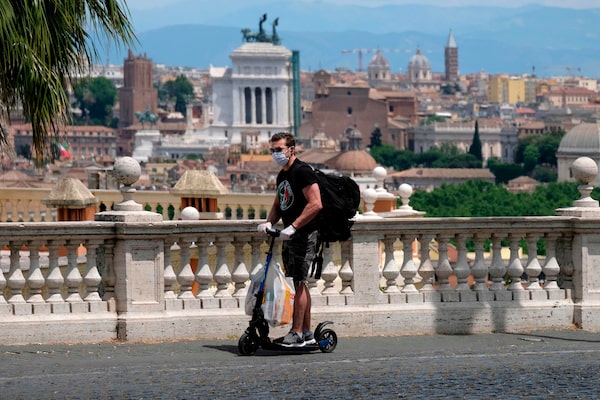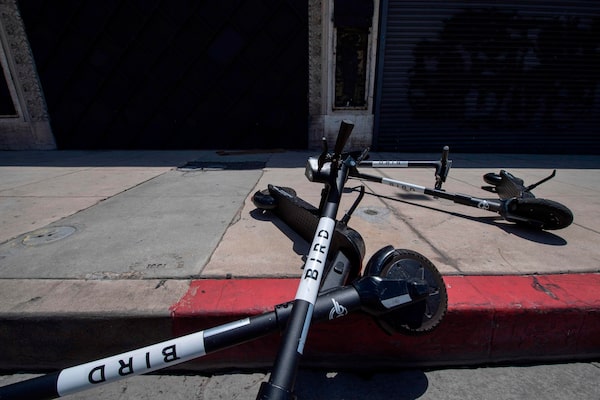
A man rides an electric scooter from the E-TWOW sharing service on Piazza del Gianicolo overloooking Rome on May 28, 2020.ANDREAS SOLARO/AFP/Getty Images
The commute as we know it may never be the same. All manner of transportation options are vying to fill the void as people stay away from public transit due to the pandemic. Instead, more urban residents may consider new devices like e-bikes and e-scooters, as well as old ones like bicycles and cars.
COVID-19 will accelerate the transition to some new transportation modes and services, according to panelists at the recent Collision from Home technology conference in Toronto.
“Safety is going to be a primary concern, and so public transit [ridership] will go down; there will be a need for other types of transit,” said Paul Asel, managing partner of venture capital firm NGP Capital, which has invested in several mobility startups, including Lime and Scoop.
In cities across the country, the coronavirus pandemic caused an unprecedented drop in transit ridership. The U.S. Centers for Disease Control and Prevention recently issued new guidelines encouraging businesses to offer employees incentives to avoid commuting by public transit or ride-sharing.
Bicycle sales jumped in April, well above last year’s numbers, according to a report from research firm CB Insights. Montreal, Vancouver, Toronto and other Canadian cities are giving over more road space to create new bike lanes and pedestrian zones.
At the same time, several studies show more people who don’t currently own cars are looking to buy one as a result of the pandemic. Canada-wide data published by Apple Maps suggests people are increasingly choosing to drive or walk, rather than take public transit, as cities across the country re-open.
The risk here is that if more people abandon transit for cars – the vast majority of which still run on fossil fuels – not only will that mean even worse traffic and longer commutes, but it would increase pollution and accelerate the world toward a climate crisis.
MICROMOBILITY’S BIG CHANCE
Micromobility companies that provide e-bikes and e-scooters – either privately owned or as part of shared fleets – see this as a chance to break into the mainstream.
“We’re seeing a very significant uptake in micromobility in the cities that are coming back,” Paul Asel said at Collision. “We’re seeing longer rides, longer duration and more frequent use, which would indicate that we’re seeing different types of commute patterns emerging to supplements the public transit.”
Companies such as Lime and Bird that offer shared, dockless e-scooters (the kind you stand up on) have been hit hard by the pandemic, having shut down service in many cities and laid off employees. Even before the pandemic, they had struggled to turn any profit, according to a report from Ark Investment Management. The pandemic could be a make-or-break moment for shared e-scooters.

Bird scooters are strewn on a street in Hollywood, Calif., on June 30, 2020.ROBYN BECK/AFP/Getty Images
Li Fan, chief technology officer at Lime, was optimistic. “We have seen very encouraging signs from markets like, say, Seoul, which is an early market to re-open – the usage is already more than [it was] pre-coronavirus,” Fan said, speaking at Collision. She noted that cities around the world are pushing to expedite the creation of infrastructure for bicycles and scooters.
“We will take this trend and really show to riders and governments that we provide a much more efficient and reliable way for people to get around,” Fan added.
Sales of personal e-scooters – which range in price from around $900 to $3,500 – are booming at Vancouver’s Urban Machina, a retailer and distributor. The shop’s founder, Ambrose Tham, said sales are up 30 per cent compared to this time last year.
“We have customers that are purchasing these to avoid commuting on public transportation,” Tham said, “but we have also seen an increase in leisure use, especially for taking on road trips and RVs.”
Demand for e-bikes – the electric bicycles you need to pedal, not the bigger Vespa-style scooters – is also surging right now.
A woman rides an electric bike through Paris on June 14, 2020.BENOIT TESSIER/Reuters
“A big part of the interest in e-bikes in general is COVID-related right now,” said Kevin McLaughlin, chief executive officer of Zygg, a new e-bike subscription service that provides users an e-bike for $69 per month. The service launched in Toronto in June.
“Long-term changes are hard to predict, but I do think that the pandemic has ‘sped up’ things that many of us have been working on for a long time – like better and safer biking infrastructure, and slow streets,” McLaughlin said via e-mail.
TRAFFIC JAMS
What exactly the commute of the future looks like still depends on some big unanswered questions.
For one thing, the pandemic has made it clear that working from home is possible for many people. How many of them will go back to the twice-daily commute once this is all over? Nobody knows.
For another thing, winter is coming. How well open-air vehicles like e-bikes and e-scooters catch on in Canada as genuine year-round alternatives to public transit remains to be seen. In part, it will depend on how well cities accommodate them.
And, finally, the shift away from public transit may not last, as Jay Walder said. He is currently chief executive of Virgin Hyperloop One, but was previously the head of public-transit agencies in New York, London and, most recently, Hong Kong. “Eight, nine years after SARS, the ridership [in Hong Kong] was at all-time highs,” Walder said at Collision. It took time for people to rebuild their confidence in public transit, he said, but eventually people returned.
Shopping for a new car? Check out the Globe Drive Build and Price Tool to see the latest discounts, rebates and rates on new cars, trucks and SUVs. Click here to get your price.
Stay on top of all our Drive stories. We have a Drive newsletter covering car reviews, innovative new cars and the ups and downs of everyday driving. Sign up for the weekly Drive newsletter, delivered to your inbox for free. Follow us on Instagram, @globedrive.